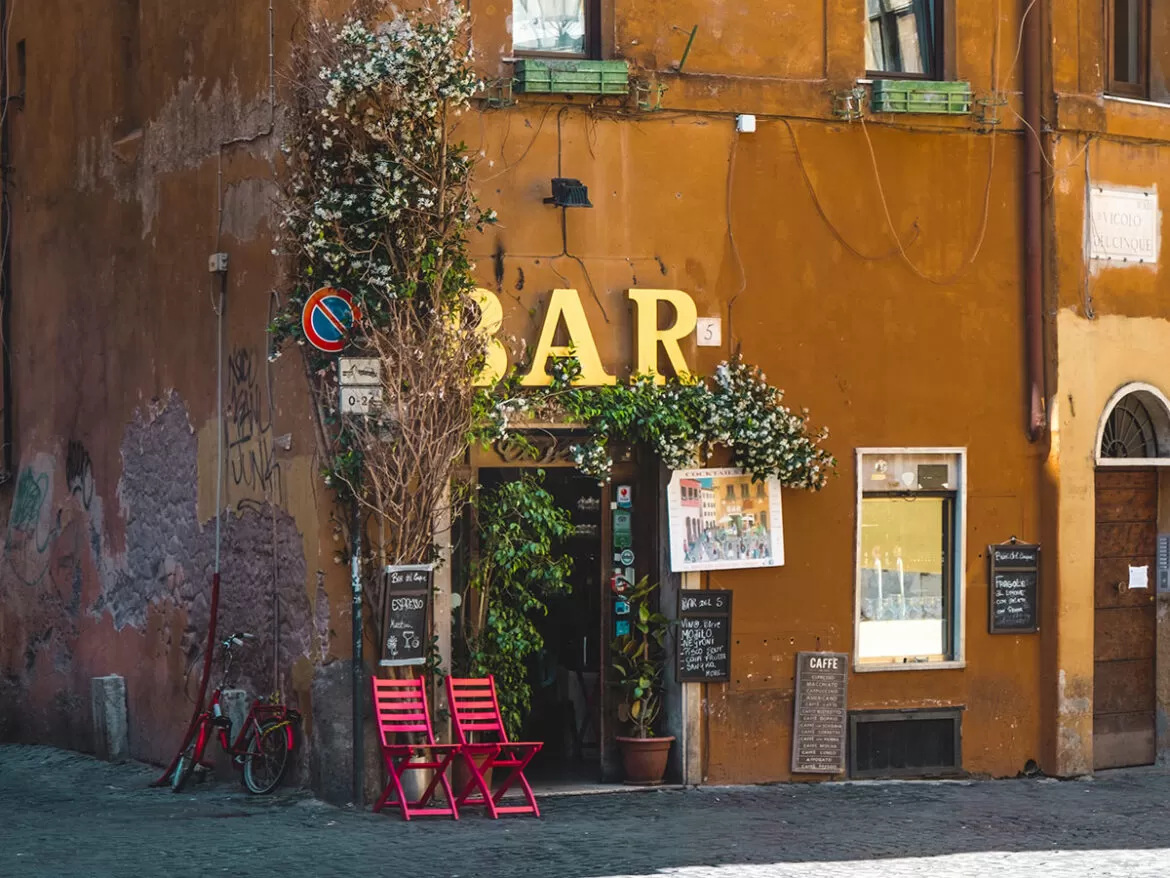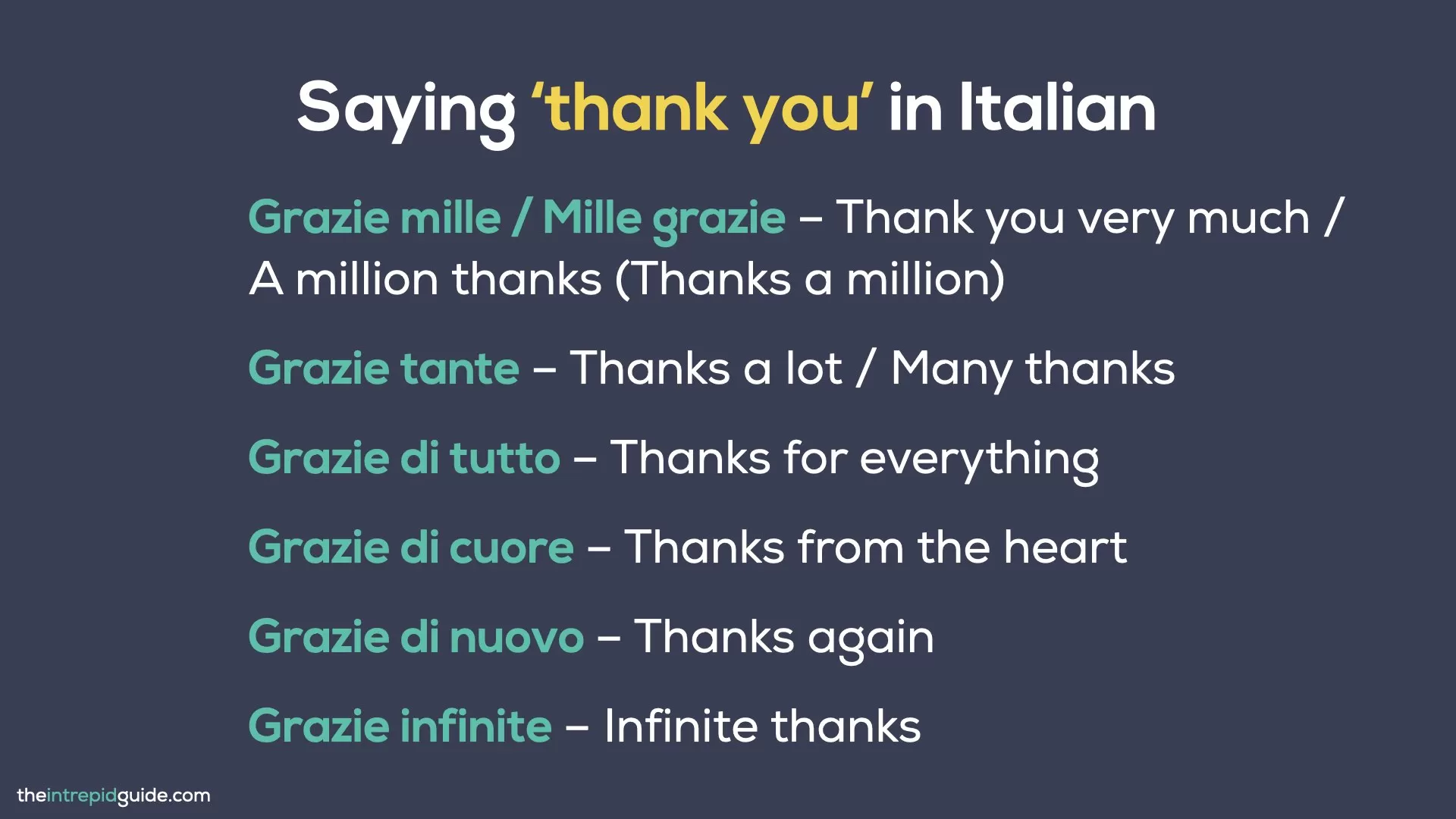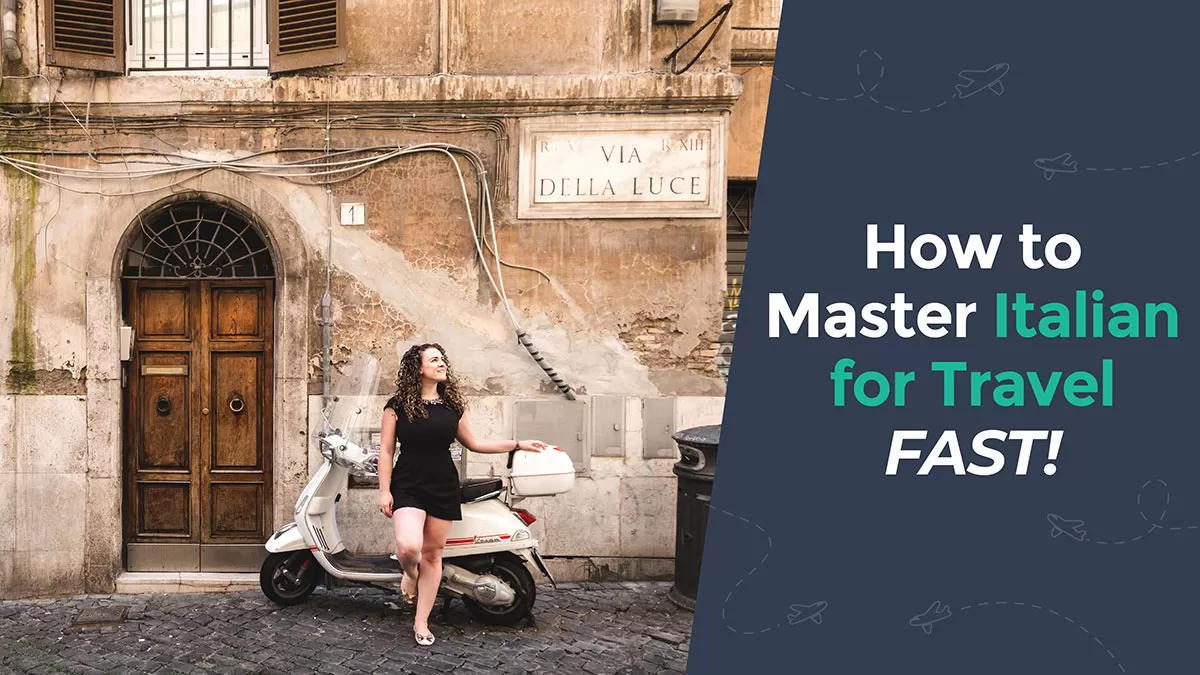Saying ‘please’ in Italian is more than just using ‘per favore’. From ‘Per piacere’ to ‘Prego’ here are 9 ways to sound like a native Italian.
Being polite is very important in Italian culture, which is why knowing how to say ‘sorry’, ‘please’, ‘thank you’ and ‘you’re welcome’ should be among the first things you learn. These magic little words will make a huge difference in your relationship with native speakers and how you experience the country as you travel around.
However, there is no single translation of the word ‘please’ in Italian. As a beginner, you are probably familiar with the most commonly used translation, per favore. However, this is not the only way to say ‘please’ in Italian and the phrases you may need to use depend a lot on the tone of the conversation, the nature of the relationship between the speakers, context, urgency, and even regionality.
Saying ‘please’ in Italian is often more than just sticking a per favore onto the end of your request. In this guide, you’ll learn how to say please in Italian in 9 different ways appropriate to various situations you’ll find yourself in.
Communicating with Italian native speakers
Bear in mind that most Italians do not speak much English, and if they do, it’s mostly a little maccheronico, or ‘macaronic’, from ‘macaroni’ (pasta): a form of broken English, heavily peppered with facial expressions, body language, and the inevitable hand gestures which are the signature of every Italian speaker.
English and Italian are quite different in their pronunciation, grammar, and vocabulary, and Italians are often quite anxious when speaking English. If you learn a few key phrases in Italian, it will help you put your Italian friends at ease when talking to them so they can communicate more successfully and easily.
You don’t have to wait until you reach fluency – Italian native speakers will feel relieved and be grateful if you use even a few phrases in Italian when talking to them. I call this level between beginner and fluent, travel fluent. Italians are generally very welcoming to people trying to speak their mother tongue, they will often be glad to chat with you and help you practice, and you will establish a connection quite fast.
However, even with the basic phrases, it is important to take nuances and connotations into account: for instance, there are different ways of saying please in Italian that may be appropriate in different situations.
One of the best ways to begin learning Italian is to start with common everyday expressions such as saying hello and goodbye, please and thank you, ordering food at a restaurant, buying something at a store, and making small talk. This way you will not only learn some Italian words and phrases, but you will also be able to start communicating in your target language from day one. To help you get started, download your free 100 most common Italian words cheat-sheet here.
This may sound a bit overwhelming, but don’t worry! By being patient and going step-by-step, you will surely master the beautiful Italian language. In this guide, I’ll help you with one of the first steps: learning how to say please in Italian.
Cominciamo! (Let’s begin!)
How to say ‘Please’ in Italian
In this guide, you will find different ways of saying please in Italian with translations, explanations, and important cultural notes.
1. Per favore
 This is probably the most common way of saying please in Italian and it is definitely the first one most beginners are taught. Its meaning is quite straightforward: it can be literally translated as ‘for favor’ or ‘as a favor’, and it originally used to describe something done as a favour to someone. For example:
This is probably the most common way of saying please in Italian and it is definitely the first one most beginners are taught. Its meaning is quite straightforward: it can be literally translated as ‘for favor’ or ‘as a favor’, and it originally used to describe something done as a favour to someone. For example:
Non sono tenuto a farlo, ma lo farò ugualmente per favore.
Meaning: I don’t have to do it, but I will do anyway as a favour.
Over the years, this term became a common politeness formula used when asking for something. For example:
Hai da accendere, per favore?
Meaning: Do you have a lighter, please?
Or, for instance, at the table:
Mi puoi passare il sale, per favore?
Meaning: Can you pass me the salt, please?
Interestingly enough, in mail etiquette, the expression per favore used to be stamped or handwritten on letters or parcels delivered personally by an assistant or middleman to the recipient, without the use of any sort of mailing service.
Generally, per favore is indeed the most suitable expression to learn as a beginner in Italian. It is versatile and has no explicit social connotations or references to rank or hierarchy. It can be used by parents talking to their children and children talking to their parents, superiors talking to their subordinates and vice versa.
It can be used in an informal context, such as a conversation with a friend, or in a more formal setting, such as a business meeting or a job interview. However, it is rarely, if ever, used in formal written documents.
However, it is important to remember that not every English ‘please’ will be translated with an Italian equivalent – an altogether different phrase could be more appropriate and used instead. For example, translating ‘yes, please’ as ‘sì, per favore’ is not technically a mistake, but people just don’t say that. Instead, sì, grazie, which literally means ‘yes, thank you’, is used instead in Italian.
2. Per piacere
 Per piacere is a close synonym of per favore and are both often perceived as interchangeable. Literally translated it means ‘for favor/courtesy/pleasure’, per piacere is also acceptable in the majority of situations.
Per piacere is a close synonym of per favore and are both often perceived as interchangeable. Literally translated it means ‘for favor/courtesy/pleasure’, per piacere is also acceptable in the majority of situations.
However, there is one very subtle difference between the two phrases. With per favore the person asking for something is reminding you to do it as a favour to them, while with per piacere the listener is asked to do something or provide something to their own advantage. It is more similar to the archaic and very polite English expression ‘If you please’ or ‘As you please’.
The expression per piacere also implies the benefit of the receiver, that they will be pleased by receiving something: the noun ‘piacere’ means ‘pleasure’ in Italian.
However, the difference between per favore and per piacere is extremely subtle and rarely conscious or intentional, so you can safely use whichever expression you prefer.
Here are a couple of examples:
Per piacere, non fate troppo rumore.
Meaning: Please, don’t make too much noise.
Per piacere, puoi venirmi a prendere alla stazione dei treni?
Meaning: Could you please pick me up at the train station?
3. Per cortesia
 Compared to the previous two expressions, per cortesia is a more formal and slightly more old-fashioned way of saying please in Italian. If you want your request to sound slightly more formal and/or respectful, you can replace per favore with per cortesia. However, this difference is not too striking.
Compared to the previous two expressions, per cortesia is a more formal and slightly more old-fashioned way of saying please in Italian. If you want your request to sound slightly more formal and/or respectful, you can replace per favore with per cortesia. However, this difference is not too striking.
Italians prefer to use this expression when actually asking someone for a courtesy. For example:
Mi fa un caffé per cortesia?
Meaning: May I have a coffee, please?
A customer at a bar or a coffee shop can ask for their drink with a per favore or per piacere, as well, without any significant difference. But by choosing per cortesia one can show a deeper sense of respect towards the barman or the barista and appreciation for their work.
When asked for something with a per cortesia, the listener might feel more motivated to give you what you ask for or provide you with an excellent service, as this expression implies a greater thankfulness towards the person giving you what you are asking for.
Here is another example:
Per cortesia, potrebbe portarmi il conto?
Meaning: Could you bring me the bill, please?
4. Cortesemente
 Cortesemente can be translated as ‘courteously’ or ‘kindly’, however, in some contexts, translating it as ‘please’ is also suitable. ‘Cortesemente’ is used in written communication or in spoken situations that are quite formal. For extra emphasis, it can be combined with phrases like si prega and La prego.
Cortesemente can be translated as ‘courteously’ or ‘kindly’, however, in some contexts, translating it as ‘please’ is also suitable. ‘Cortesemente’ is used in written communication or in spoken situations that are quite formal. For extra emphasis, it can be combined with phrases like si prega and La prego.
Interestingly, adding cortesemente makes a sentence that would otherwise sound rather rude in English sound very polite in Italian. For example:
Cortesemente, mi servirebbe il fascicolo del signor Rossi.
Meaning: Courteously, I need Mr. Rossi’s file.
Saying ‘I need Mr. Rossi’s file’ – even with ‘please’ added to it – is not always an appropriate way to ask for something, and a more suitable option would be ‘Could I have Mr. Rossi’s file, please?’ However, in Italian, it is a perfectly acceptable polite formal request.
Cortesemente can, of course, also be used in polite interrogative sentences, as in the following example:
Potresti cortesemente passarmi il sale?
Meaning: Could you please pass me the salt?
As you have seen in the example above, per favore can be used in the same context. This request, however, is much more formal. You can imagine that, while in the previous example we were at the table with a relative or a friend, in this case, we are having a business lunch, or we are eating with someone we deeply respect, don’t know well, or even fear.
Using cortesemente brings the conversation to a very formal written or spoken level. And on this note, we can safely say that it is mostly used in written communication rather than spoken one, such as in public signs and warnings, such as:
Cortesemente, chiudere il cancello.
Meaning: Kindly close the gate.
This is a generic request to whoever is using the gate, say, in a large apartment block; however, it is very polite and quite formal.
5. Gentilmente
 Gentilmente is a close synonym of cortesemente, just a bit less formal and more friendly, possibly used in family situations or with people we know, when we want to be extra kind. It is rarely seen in a written form. Translated literally, it means ‘kindly’, ‘courteously’, ‘politely’.
Gentilmente is a close synonym of cortesemente, just a bit less formal and more friendly, possibly used in family situations or with people we know, when we want to be extra kind. It is rarely seen in a written form. Translated literally, it means ‘kindly’, ‘courteously’, ‘politely’.
It is often used in affirmative sentences, expressing a need that we want to be fulfilled. For example:
La prego gentilmente di spegnere il microfono.
Meaning: I kindly ask you to turn your microphone off.
In English, a similar effect is usually achieved by using a modal verb like in, ‘Could you please turn your microphone off?’
An interrogative sentence with a similar meaning is possible in Italian. For example:
Potrebbe cortesemente spegnere il microfono?
Meaning: Could you please turn your microphone off?’
However, it conveys a higher sense of urgency and denotes that, in some way, some sort of nuisance was created by this person’s microphone which needs to be addressed or solved immediately.
6. Ti prego, La prego, Vi prego
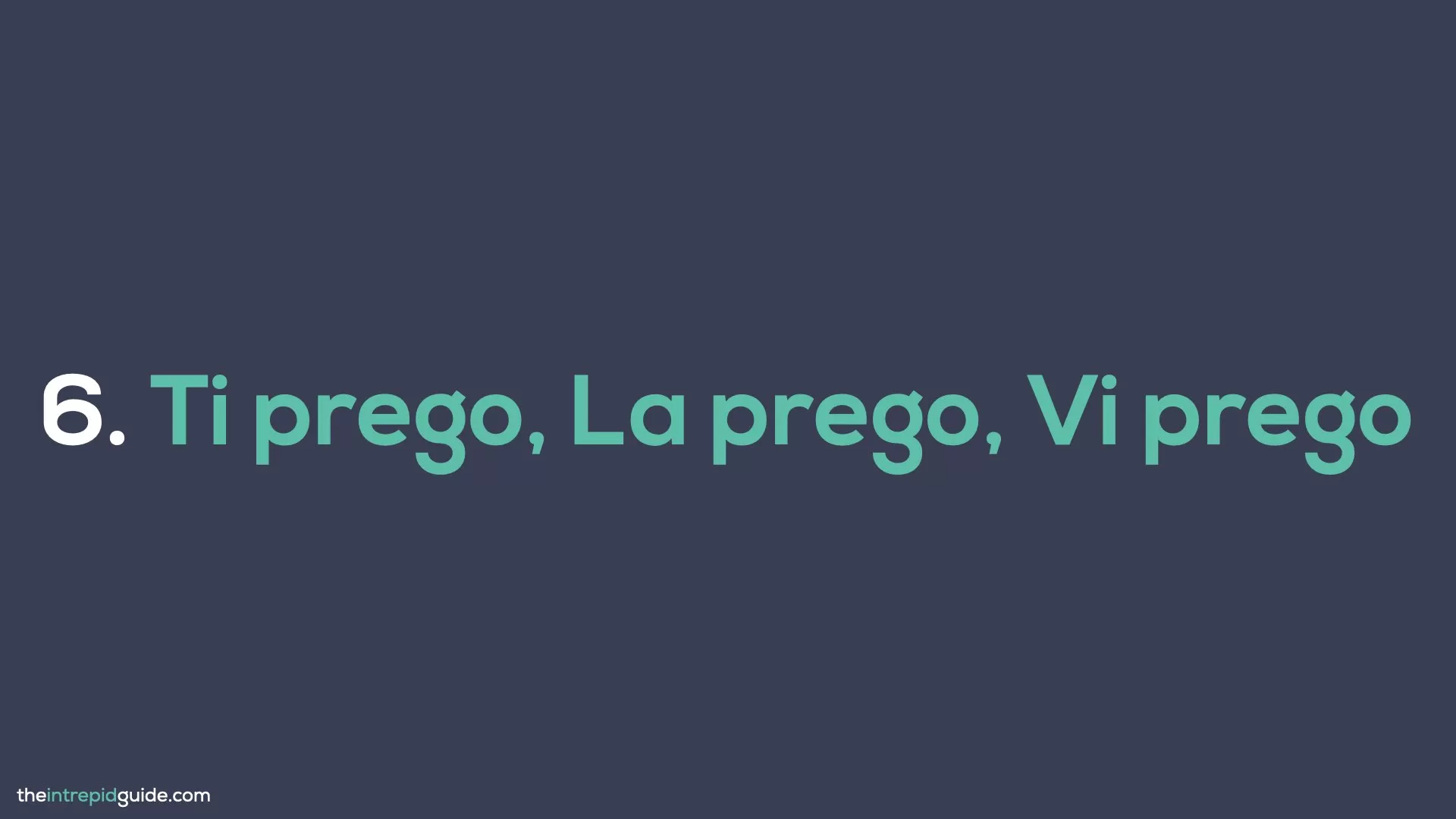 Prego is the first person singular conjugation of the Italian verb pregare (to ask, pray, beg), and by using one of these expressions, we are practically begging for something. Ti prego (I beg you [informal]), La prego (I beg you [formal]), or Vi prego (I beg you [plural]) expresses a deep need for something as if we were asking for something our life literally depends on or something we strongly desire – it can sound quite dramatic, so make sure not to overuse it.
Prego is the first person singular conjugation of the Italian verb pregare (to ask, pray, beg), and by using one of these expressions, we are practically begging for something. Ti prego (I beg you [informal]), La prego (I beg you [formal]), or Vi prego (I beg you [plural]) expresses a deep need for something as if we were asking for something our life literally depends on or something we strongly desire – it can sound quite dramatic, so make sure not to overuse it.
Quite often, choosing this expression reflects our feeling that the person we are begging for something is not keen on doing us a favour: like, for instance, a teenager begging their parents for a night out, or someone begging for mercy in a desperate situation – which means it is probably not the best phrase to use in a cafe or any other typical every-day situation.
However, if you need what you are asking for really badly, or if you have asked for it multiple times and/or your chances of getting it are slim, this may be just the phrase you need.
Ti prego, fammi usare la tua auto!
Sounds almost like: I’m begging you, let me use your car! Rather than a simpler and less urgent: Please, let me use your car.
Which, in Italian, would be: Per favore, fammi usare la tua auto.
The request made with the use of per favore is definitely less urgent and desperate.
Judging by the choice of words alone, we can sometimes see the whole situation quite clearly. For example:
Mamma, ti prego, fammi andare al concerto!
Meaning: Mom, please (I’m begging you), let me go to the concert!
This is probably a teenager, who has been asking their mom to go to this concert for quite a while and has heard a lot of ‘no’s’. However, they still really really want to go, and all of their friends are going too.
Or, the other way around, an exhausted parent might be asking their child:
Marco, ti prego, finisci i compiti!
Meaning: Marco, I’m begging you, finish your homework!
We immediately know that Marco has been putting off doing his homework for quite some time and he probably does it regularly – his mom or dad is not just annoyed, but exasperated.
In using this expression, the tone and level of respect are signalled by the choice of pronoun ti, la, or vi: as you probably already know, Italians differentiate these direct object pronouns while in English all of them can be translated as ‘you’.
If you choose ti, you are talking to someone you know quite well, like a friend, a coworker, or a family member. La indicates distance and respect, it is chosen when addressing older people, teachers, our superiors, strangers, especially in a formal or professional context. Vi can be chosen as an equivalent of ti when we are talking to multiple people (the English ‘you’ in the second person, plural).
Vi can also demonstrate a higher level of distance and politeness than La, however, this is rarely seen nowadays. It is mostly used in the Southern regions of the country, to show an extreme form of respect. It used to be the way of addressing royalties, members of the Church, ambassadors, and consuls, but in the past century, it came to be associated with the fascist regime and Mussolini’s dictatorship, and this is the main reason why it has been progressively abandoned by the average Italian speaker.
7. Si prega di… / Siete pregati di…
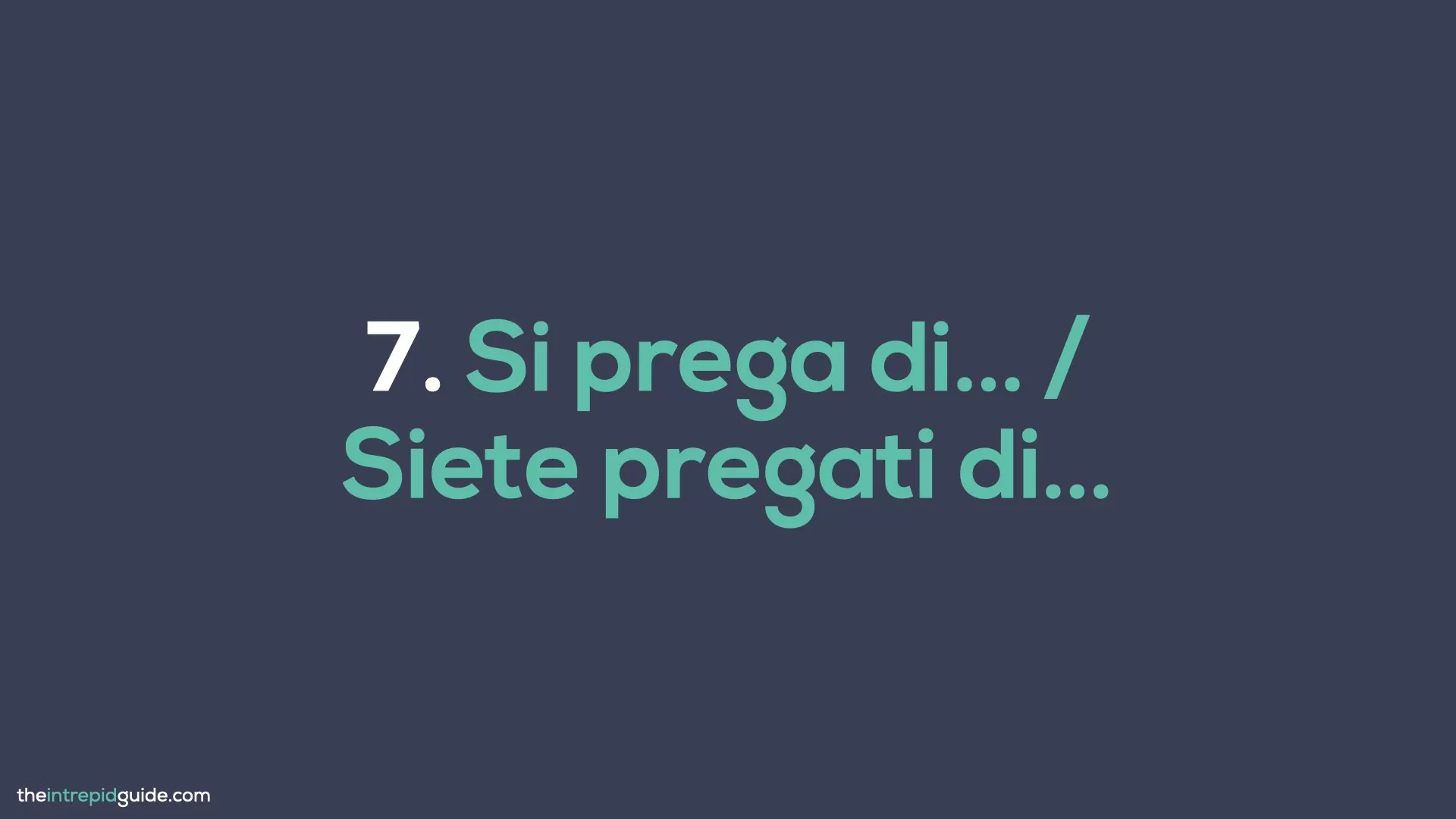 The expressions Si prega di… and Siete pregati di… use the same verb pregare (to beg) as in the previous section but in its impersonal form. It is very rarely used in speech, you will mostly come across it in written form and in a rather formal context.
The expressions Si prega di… and Siete pregati di… use the same verb pregare (to beg) as in the previous section but in its impersonal form. It is very rarely used in speech, you will mostly come across it in written form and in a rather formal context.
Si prega di… is a rather ceremonious, official and polite way of requesting something. It is not directed at any specific person, but at the public in general – that is why it is most commonly used for various instructions, rules, and prohibitions.
You may see it written on billboards, notice boards, signs, and in users’ manuals, in schools, universities, and public offices, on public transportation, in industrial and commercial settings, too; you may hear it only on special, very formal occasions, on the TV or the radio, in official speeches intended for a wide audience.
The second version of this expression, Siete pregati di…, is a little more direct as it addresses a generic second plural person, sounding slightly less formal and more straightforward, but still fairly impersonal and official.
A voice message on a speaker at a store might warn you that it’s almost closing time with a message like this:
Si prega la gentile clientela di avvicinarsi all’uscita.
Meaning: We invite our kind customers to approach the exit.
In Italian, this sounds extremely polite and well-mannered while it is still asking you to quickly finish doing your shopping and leave the place as soon as possible.
On a train or a bus, for instance, a sign might warn you that you are not allowed to smoke, in a polite way, such as:
Si prega di non fumare or Siete pregati di non fumare
Which we could translate to: ‘Please do not smoke’ rather than the usual ‘no smoking’ which is more direct and straight to the point, but could sound a little rude to the Italian ear.
As you may remember, politeness is extremely important in Italian culture – even when imposing strict rules.
8. Prego
 Prego literally means ‘I pray’ or ‘I beg’, and it may seem like an unusual way to say please in Italian. The more common use of ‘prego’ is in reply to grazie (thank you), as an equivalent of the English ‘you are welcome’. However, in certain contexts, it is also an equivalent of the English ‘please’.
Prego literally means ‘I pray’ or ‘I beg’, and it may seem like an unusual way to say please in Italian. The more common use of ‘prego’ is in reply to grazie (thank you), as an equivalent of the English ‘you are welcome’. However, in certain contexts, it is also an equivalent of the English ‘please’.
Unlike the examples above, ‘prego’ is not used to ask questions or make requests. It becomes the Italian equivalent of please when the speaker is making an invitation or giving someone permission to do or take something.
For example, when a friend is inviting us to their place, we may hear something like:
Prego, entrate.
Meaning: Please, come in.
Later on, when gathering in the dining room, the hosts might invite us to sit down at a specific spot with a polite:
Prego, si sieda qui.
Meaning: Please, sit down here.
On the phone or at the reception, talking to a secretary or a nurse, you might be addressed with a: Prego, mi dica
Which invites you to explain what you need, and can be literally translated as: Please, tell me
Once again, it is a rather formal way of saying please in Italian, but still very effective and polite.
9. Per carità
 Calling this a way of saying please in Italian is a bit of a long stretch, but it is still worth mentioning. Per carità literally means ‘by charity’, and it is mostly used as an exclamation: the person using it is most likely overwhelmed, annoyed, or wants to emphasize what is going on.
Calling this a way of saying please in Italian is a bit of a long stretch, but it is still worth mentioning. Per carità literally means ‘by charity’, and it is mostly used as an exclamation: the person using it is most likely overwhelmed, annoyed, or wants to emphasize what is going on.
This expression usually corresponds to the English ‘for goodness’ sake!’, but occasionally it can be used as a very expressive, even dramatic ‘please’, as in:
Smettetela per carità!
Meaning: Stop it, please / Stop it for goodness’s sake!
Through this choice of words, you can clearly feel the exasperation of the speaker.
A famous example is from the opera buffa The Barber of Seville (Italian: Il barbiere di Siviglia), when Figaro is asking his patrons to come in for his services one at a time:
Uno alla volta, uno alla volta, uno alla volta per carità!
Meaning: One at a time, one at a time, one at a time, I beg you, please!
The song by Gioacchino Rossini is a popular example of Italian opera, one of the biggest points of pride and passion for Italian people.
Listen to this extract from the 3:36 minute mark.
Quotes and more examples
Similar to the example above, there are lots of songs, poems, books, and movies that can help you memorize these ways of saying please in Italian and give you practical examples of their uses. Let’s take a look at a few!
In her famous hit La Solitudine from 1993, Laura Pausini sings:
Ti prego aspettami amore mio.
Meaning: Please wait for me, my love.
With the choice of ti prego, it sounds close to desperate begging, which is quite common for love songs.
Many children’s books teach the importance of the magic polite words, such as Chiedi per favore, where a rude hippo needs to learn to ask kindly for what he wants in a conversation that goes as follows:
Dammi un palloncino. — Chiedi per favore!
Meaning: Give me a balloon. — Ask, please!
Because it’s never too early to learn good manners!
Saying ‘thank you’ in Italian
You can’t truly learn how to say please in Italian without also learning to say thank you. After all, if you ask someone to do you a favour and they do it, you need to thank them for it!
You’ve seen above that there are many ways of saying please in Italian – there are at least as many, if not more, ways to say thank you. But there is one key word at the heart of most of them: grazie (thank you).
Attenzione! (Be careful!) Don’t confuse ‘grazie’ with ‘grazia’ which means ‘grace’ while ‘grazie’ is the plural form of this noun which has become the most common way of saying thank you in Italian.
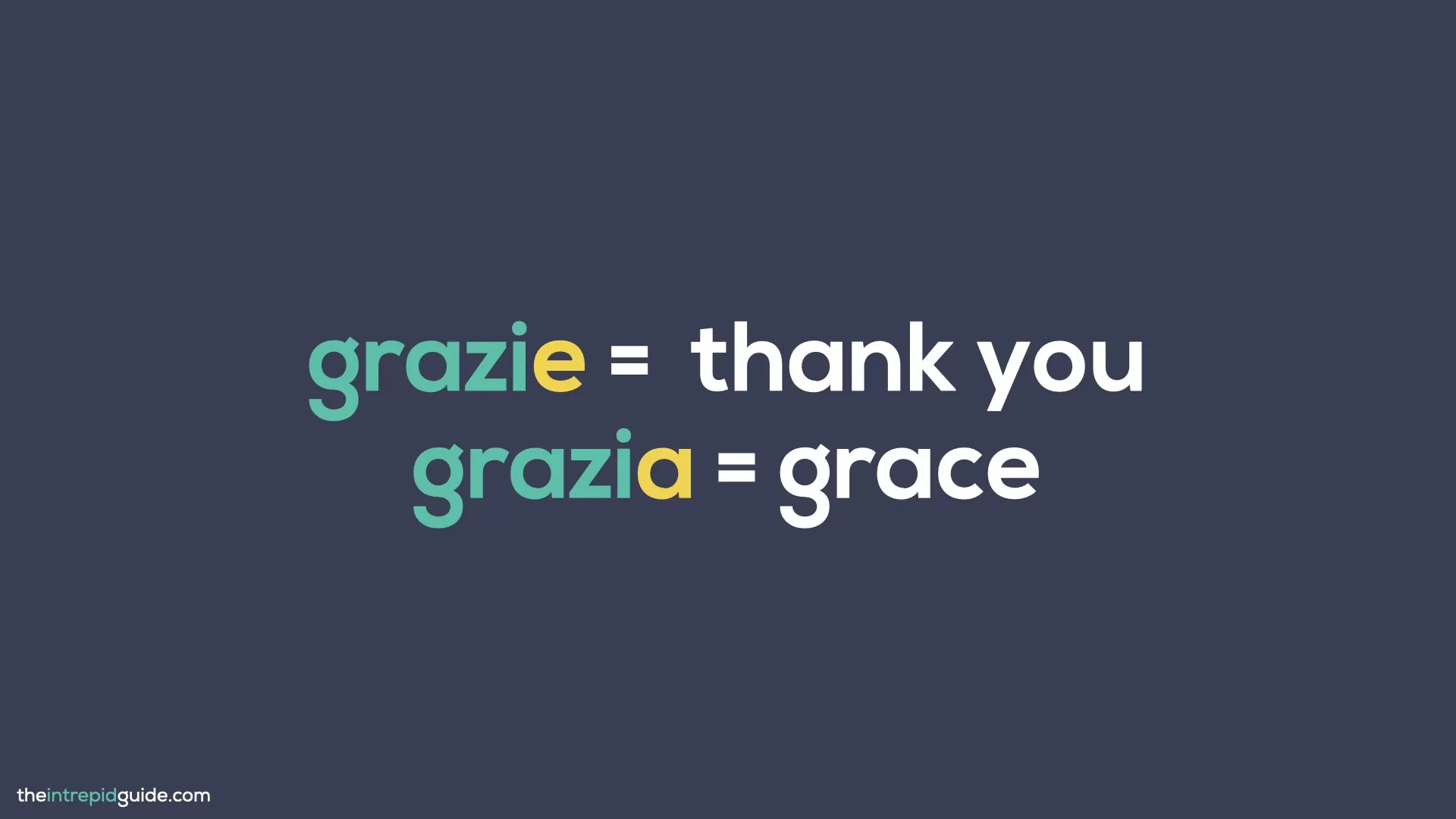
Similar to per favore, grazie is a versatile expression – it can be used to thank anyone, anywhere, at any time. But if you want to be more expressive or add a certain flavour to your ‘thank you’, you can add many different words to grazie:
- Grazie mille / Mille grazie. – Thank you very much / A million thanks (Thanks a million).
- Grazie tante. – Thanks a lot. / Many thanks
- Grazie di tutto. – Thanks for everything.
- Grazie di cuore. – Thanks from the heart.
- Grazie di nuovo. – Thanks again.
- Grazie infinite. – Infinite thanks.
In a formal situation, you can also say
La ringrazio tanto.
Meaning: Thank you very much.
And, of course, if someone says grazie to you, don’t forget to reply with a ‘prego’ (you are welcome) to be polite.
To sum it all up
There are many ways of saying please in Italian: some are more versatile, like per favore, others are more formal, emotional, or even dramatic.
If you are just beginning to learn Italian, starting with the most common option is totally fine. However, if you want to be more fluent in Italian, communicate with native speakers on many topics, and be able to understand and convey nuanced meanings, a simple per favore may not be enough.
Italian is a beautiful language with hundreds of nuanced expressions for different situations. Now you know the ones that will help you say please in Italian and be polite in any formal or informal context.
Learn Italian FAST! Enrol in my popular Italian course here.
Learn Italian with me, Michele, The Intrepid Guide!
Travelling to Italy? Don’t be treated like a tourist! Live your best travel experiences and learn Italian for less than the cost of eating at a tourist trap restaurant or a taxi driver who has “taken you for a ride”. In addition to my free Italian travel phrase guides, I’ve made it even easier for you to master the Italian language so you can create lifelong memories as you mingle with locals, get local tips, avoid tourist traps, and make new friends. Who knows you, you might even be invited over for afternoon tea by a lovely Sicilian family like I was! Read all about how speaking Italian changed my life and check out The Intrepid Guide Languages courses here.
Here’s what my students are saying:

I really enjoyed the Master Italian for Travel FAST course, it certainly exceeded my expectations. The learning methodology is great, and easy to follow and found that I progressed much faster in the last 4 weeks than I ever did on my own or using other language apps. Grazie mille Michele, I can’t wait until I can put my new skills into action! – Roma Small
Click here for instant access!
Learning Italian? Check out these Italian language guides
- 41 Italian Greetings: How to Say ‘Hello’ in Italian Like a Local
- TOP 100 Most Common Italian Words (Plus PDF Cheat-Sheet & Quiz)
- 10 Ways Natives REALLY Say ‘You’re Welcome’ in Italian
- 125 Most Common Italian Phrases for Travel You’ll Ever Need [PLUS Printable]
- Is Italian Hard to Learn? 7 Common Mistakes & How to Avoid Them
- Master Days of the Week in Italian (7 Simple Memory Hacks)
- Italian Numbers: How to Count in Italian From 0 to 1 Billion (Plus PDF Download)
- How to Order Food & Drinks in Italian [Italian for Beginners]
- 15 Italian Words You Should NEVER Mispronounce [& How Not To]
- 11 Effective Hacks That’ll Help You Learn Italian So Much Faster
- Top 14 Italian Words You Should NEVER Say [& What to Use Instead]
- 20 Hilarious Everyday Italian Expressions You Should Use
- Romanesco: 25 Cool Roman Dialect Words You Should Use in Rome
- 10 Reasons Why Learning Italian Will Change Your Life
- 10 Italian Expressions Italians Love Saying
- Italian for Beginners | 8 DEADLY Mistakes in Italian (& How to Avoid Them)
- 10 Italian Phrases That Will Instantly Make You Sound more Italian
- Funny Italian Sayings: 26 Food-Related Insults You Won’t Forget
- 15 Romantic Italian Films That’ll Make You Love Italy Even More
- How to Master Common Italian Phrases for Travel (Like a Local!)
- How to Conjugate Italian Verbs in 3 Simple Steps [Italian for Beginners]
Like it? Pin it for later!
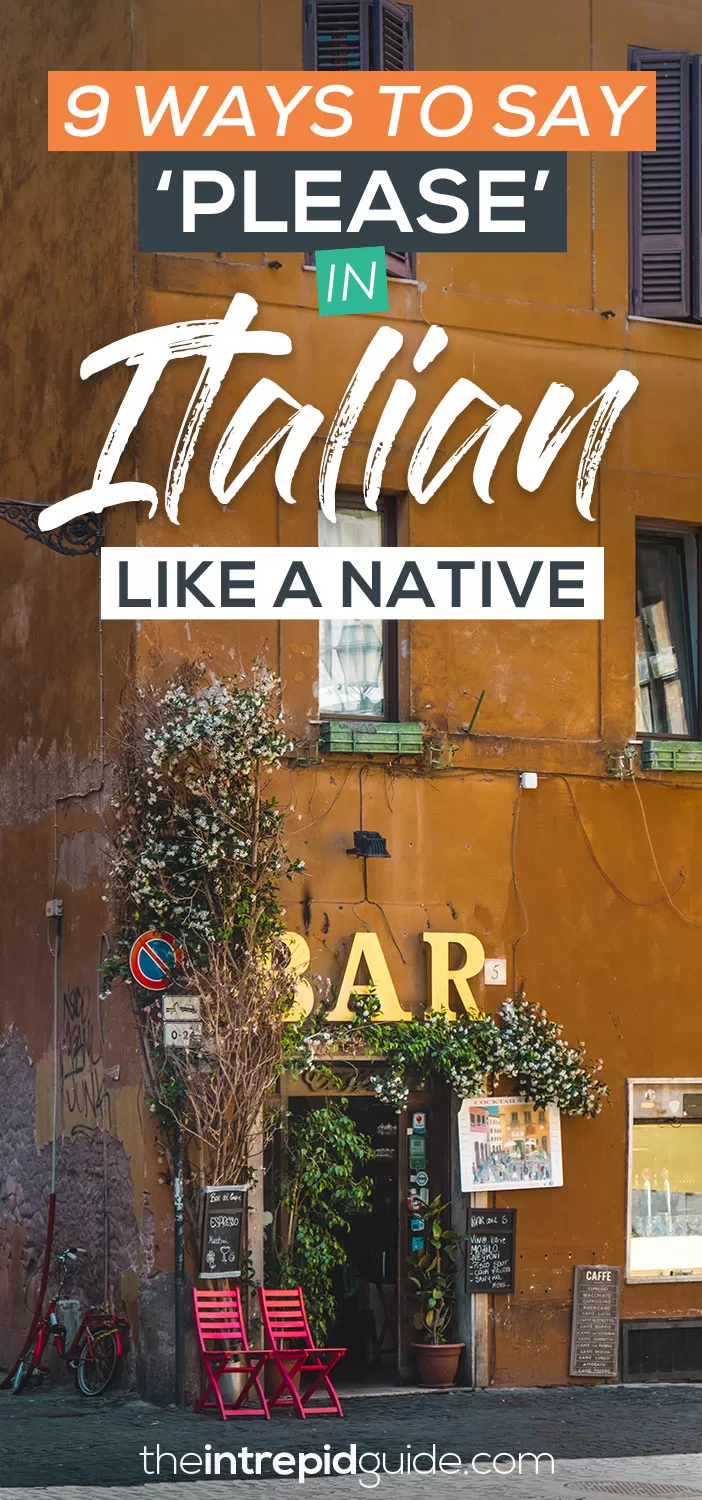
Over to you!
Which of these phrases do you use the most? Which expression will you start using more? Let me know using the comments section below or join me on social media to start a conversation.
Thanks for reading and I hope you enjoyed this post.
Like what you see? Subscribe using the form below to have all of my posts delivered directly to your email.

